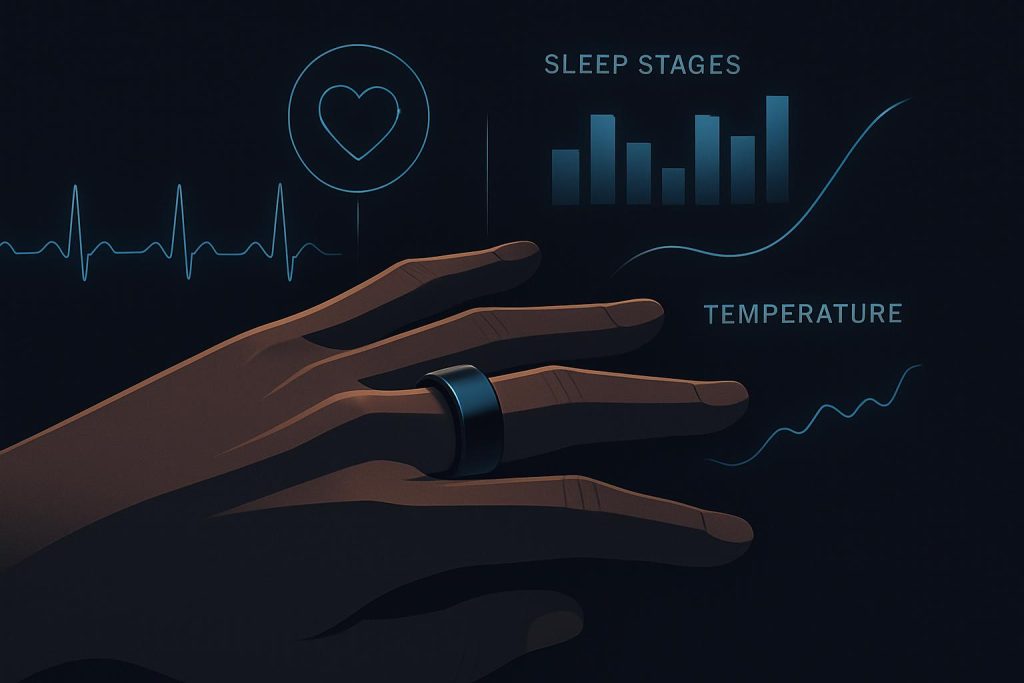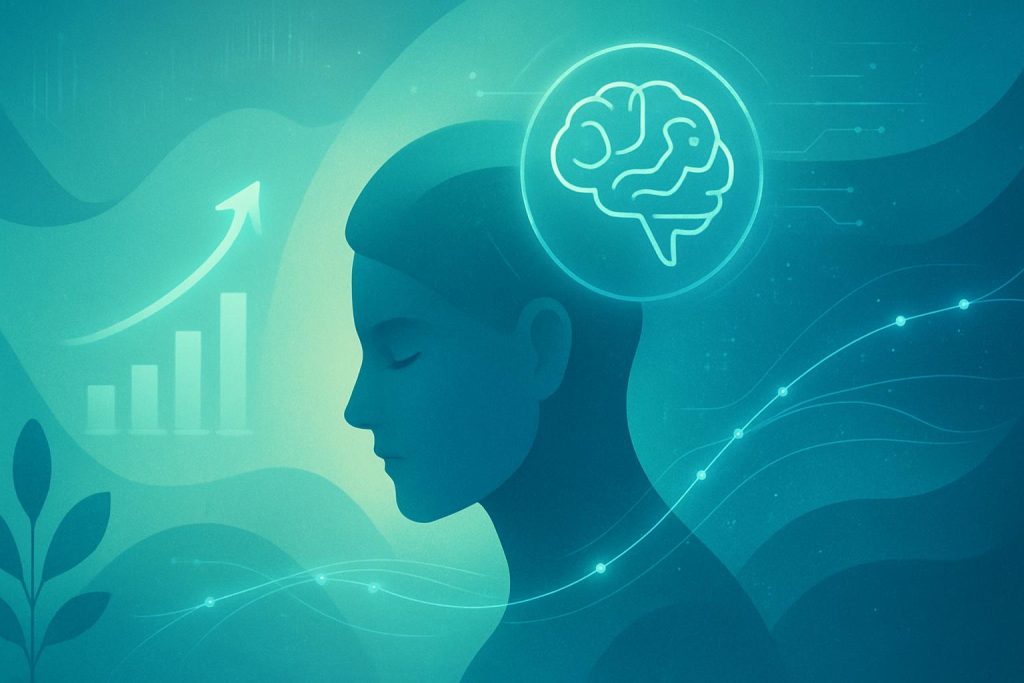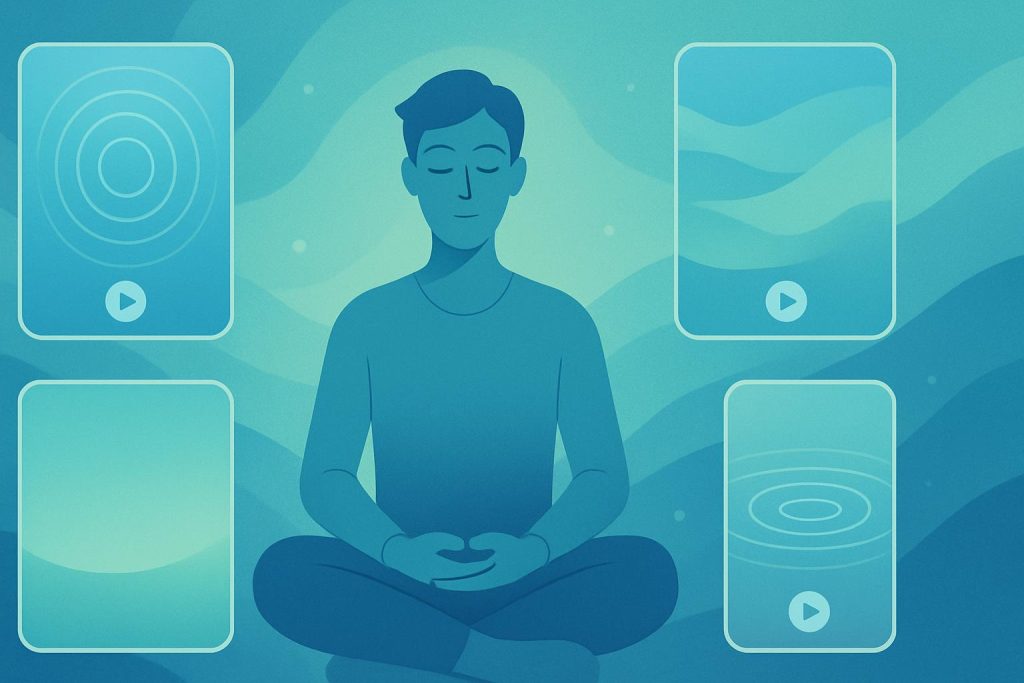- The technology behind the Oura Ring: Sensors and data collection.
- Detailed breakdown of Oura’s core metrics: Sleep Score, Readiness Score, Activity Score, and their contributors (HRV, temperature, sleep stages, etc.).
- How Oura’s AI algorithms analyze data to generate personalized insights and guidance.
- Specific features for sleep optimization: Sleep staging (Light, Deep, REM), nighttime HRV, respiratory rate, body temperature deviation.
- Using the Readiness score to balance activity and recovery for better mental and physical resilience.
- The Oura Ring affiliate program for partners and promoters.
- Practical application, benefits, limitations, and comparisons to other sleep tracking methods.
Inside the ring: Oura’s sensor technology
- Infrared PPG Sensors: These sensors measure heart rate, heart rate variability (HRV), and respiratory rate by detecting changes in blood volume in the finger arteries. Infrared light is less susceptible to interference from skin pigmentation compared to the green light used in many wrist wearables.
- NTC Body Temperature Sensor: Measures skin temperature deviation throughout the night with high sensitivity (detecting changes as small as 0.1 degrees Celsius). This is crucial for tracking circadian rhythm, illness detection, and potentially predicting menstrual cycles.
- 3D Accelerometer: Tracks movement to determine activity levels during the day and restlessness or wakefulness during sleep.
These sensors work together, collecting thousands of data points continuously, providing the raw material for Oura’s sophisticated analysis.
Decoding Oura’s scores: Sleep, Readiness, Activity
- Sleep Score: Evaluates overall sleep quality based on:
- Total Sleep: Duration of sleep.
- Efficiency: Percentage of time in bed actually spent asleep.
- Restfulness: Amount of tossing and turning or wake-ups.
- REM Sleep: Time spent in the mentally restorative REM stage.
- Deep Sleep: Time spent in the physically restorative deep sleep stage.
- Latency: How quickly you fell asleep.
- Timing: Alignment of sleep schedule with your body’s natural circadian rhythm.
- Readiness Score: Assesses your capacity to perform mentally and physically, indicating recovery status. Key contributors include:
- Previous Night’s Sleep Score.
- Sleep Balance: Comparison of recent sleep to long-term needs.
- Previous Day Activity: Impact of yesterday’s physical exertion.
- Activity Balance: Balance between recent activity and rest over time.
- Body Temperature: Deviation from your baseline.
- Resting Heart Rate (RHR): How low your heart rate dropped during the night.
- Heart Rate Variability (HRV) Balance: Comparison of recent HRV to your baseline.
- Recovery Index: How quickly your heart rate stabilized during the first half of the night.
- Activity Score: Measures how well you are balancing activity, inactivity, and rest throughout the day. Contributors include:
- Stay Active: Frequency of avoiding long periods of inactivity.
- Move Every Hour: Consistency in getting up and moving.
- Meet Daily Targets: Progress towards personalized activity goals.
- Training Frequency & Volume: Balance of workouts over time.
- Recovery Time: Ensuring sufficient rest days between intense activities.
These scores provide a quick daily check-in, while drilling down into the contributors reveals detailed insights.
AI-driven insights and personalization
- Sleep Staging Algorithms: Analyze HRV, heart rate, temperature, and movement patterns to accurately estimate time spent in Light, Deep, and REM sleep stages.
- Baseline Calculation: Learns your individual norms for metrics like HRV, RHR, and temperature over time, allowing it to detect significant deviations.
- Personalized Recommendations: Based on your scores and data trends, the app provides tailored advice, such as suggesting an earlier bedtime after a night of low deep sleep, recommending a rest day if Readiness is low, or encouraging more movement if activity goals aren’t met.
- Trend Analysis: Identifies long-term patterns and correlations, helping users understand how lifestyle factors impact their biometrics.
- Predictive Features (Potential): Features like Period Prediction leverage temperature data analysis.
Optimizing rest with Oura data
- Detailed Sleep Stages: Understanding the balance between Light, Deep, and REM helps identify specific areas for improvement (e.g., consistently low deep sleep might prompt investigation into sleep environment or pre-bed routines).
- Nighttime HRV: Tracking HRV trends during sleep provides a powerful indicator of recovery and nervous system balance. Lower-than-usual HRV can signal stress, illness, or overtraining.
- Resting Heart Rate: A consistently low RHR during sleep is a good sign of cardiovascular fitness and recovery. Spikes can indicate stress or illness.
- Body Temperature Deviation: Subtle changes can signal the onset of illness even before symptoms appear, or reflect hormonal changes. Consistent temperature patterns support circadian rhythm analysis.
- Respiratory Rate: Significant deviations from baseline breathing rate during sleep can sometimes indicate health issues.
Readiness: Balancing stress and recovery
- High Readiness: Suggests your body is well-recovered and capable of handling challenges, both physical and mental.
- Low Readiness: Indicates physiological stress or incomplete recovery. The app typically advises prioritizing rest, light activity, and stress reduction.
Practical considerations
- Cost: Oura Ring involves an upfront hardware cost plus an ongoing monthly membership fee for full data access and insights.
- Comfort: Designed to be worn 24/7, comfort is generally high but subjective.
- Accuracy: While considered highly accurate for a consumer wearable, especially for temperature and HRV, it is not a medical device.
- Data Interpretation: Requires some learning to fully understand and utilize the wealth of data provided.
- Actionability: The value lies in using the insights to make tangible lifestyle changes.
Precision data for optimized living
The Oura Ring represents the cutting edge of consumer wearable technology for sleep and recovery tracking. By integrating multiple high-fidelity sensors into a discreet ring and applying sophisticated AI analysis, it delivers detailed insights into sleep stages, heart rate variability, body temperature, and overall physiological readiness. These insights empower users to move beyond generic advice and make data-driven decisions to optimize their sleep, balance activity with recovery, and enhance their mental and physical resilience. While requiring an investment, for those committed to understanding and improving their body’s performance and recovery cycles, the Oura Ring, with its associated affiliate opportunities, provides an unparalleled toolset, directly supporting the goal of enhancing rest as discussed in Enhance sleep quality: AI tools for better rest cycles and Improving your mental health: strategies and AI tools.



